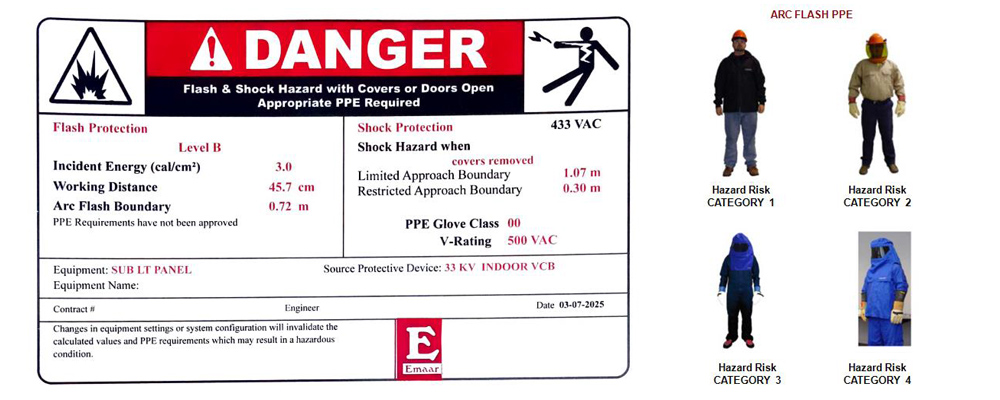What is Arc Flash Study?
Arc Flash Study is a detailed engineering analysis carried out to determine the incident energy levels and arc flash boundaries in an electrical system.
It uses advanced simulation software (like ETAP or equivalent) to model the system, calculate short-circuit levels, and determine fault clearing times. The objective is to assess the arc flash hazards, ensure compliance with IEEE 1584 and provide appropriate protection measures for people and equipment.
How Arc Flash Study is Useful?
Arc flash events release enormous heat, pressure, and light energy, causing severe burns, equipment damage, and even fatalities.
Arc Flash Study helps to:
- Identify hazardous zones around electrical equipment.
- Calculate incident energy levels and arc flash boundaries.
- Recommend correct PPE (Personal Protective Equipment) for safe working.
- Ensure coordination of protection devices (breakers, relays, fuses).
- Comply with international safety standards.
Ultimately, it protects personnel, prevents equipment damage, and reduces downtime.

Applications of Arc Flash Study
1. In Switchyard & Substations
- Determines safe working distance from busbars, VCB, CT/PT panels.
- Helps in labeling and PPE requirements for operators.
2. In Transformers & Switchgears
- Identifies possible arc flash hazard levels on LV/MV/HV switchgears.
- Suggests improvements in protection coordination.
3. In Industrial Plants
- Prevents arc flash incidents in MCCs, distribution panels, and process equipment.
- Reduces unplanned outages due to miscoordination.
4. In Data Centers / IT & Service Industries
- Protects expensive UPS, panels, and servers from electrical faults.
- Prevents fire and business interruption losses.
5. Broadly, the Following Can be Observed
- Inadequate protection coordination.
- Improper relay/breaker settings.
- High incident energy exposure.
- Absence of arc flash warning labels.
- Non-compliance with IEEE 1584.
- Risk of severe injuries to operators working on live panels.
Arc flash hazards continue to threaten the safety of people and property in the form of burns, fire, and explosions. With industries depending heavily on reliable electricity, managing arc flash risks is critical.
Typical Scope of Study
- Data Collection – Load details, equipment ratings, breaker settings.
- Short Circuit Study – To calculate maximum and minimum fault currents.
- Protection Coordination Study – Relay/breaker setting optimization.
- Arc Flash Analysis – Incident energy calculation as per IEEE 1584.
- Arc Flash Labeling – Displaying arc flash boundary, PPE category, and incident energy level on panels.
- Safety Recommendations – Mitigation steps (relay upgrades, breaker settings, etc.).
Methodology
- Pre-Study Questionnaire
- Site Audit – Physical inspection of panels, switchgears, and protective devices.
- System Modeling – Develop single line diagram in ETAP (or equivalent).Short Circuit & Relay Coordination Analysis
- Arc Flash Hazard Calculation – Incident energy, boundary, PPE category.
- Discussion with Client – Explain results, risks, and solutions.
- Report Submission – Comprehensive arc flash study report with recommendations, PPE matrix, and compliance guidelines.
